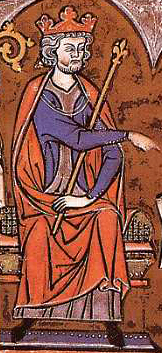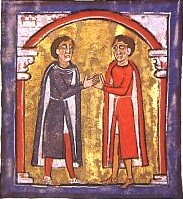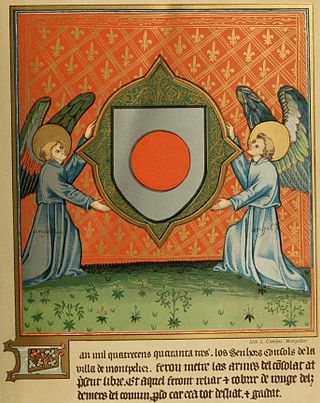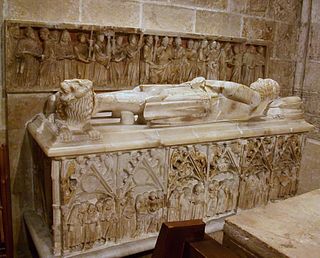William IV (or Guillem IV) was the Lord of Montpellier from 1058 until his death in 1068. [1] He was the son of William III and Beliardis. He was married to Ermengarde, daughter of Raymond I, Count of Melgueil. He is the first of his dynasty with charters preserved in the family cartulary, the Liber instrumentorum memorialium . They record agreements concerning some local castles in 1059. [1] He was succeeded by his son, William V.

James I the Conqueror was King of Aragon, Count of Barcelona, and Lord of Montpellier from 1213 to 1276; King of Majorca from 1231 to 1276; and King of Valencia from 1238 to 1276. His long reign of 62 years is not only the longest of any Iberian monarch, but one of the longest monarchical reigns in history, ahead of Hirohito but remaining behind Queen Elizabeth II, Queen Victoria, and Ferdinand III of Naples and Sicily.
William II Jordan was the count of Berga beginning in 1094, the count of Cerdanya beginning in 1095, and regent of the County of Tripoli beginning in 1105.
The Lordship of Montpellier was a feudal jurisdiction in Languedoc with its centre in the city of Montpellier, that existed between 986 and 1344.
Eudokia Komnene was a relative of Byzantine Emperor Manuel I Komnenos, and wife of William VIII of Montpellier.

Marie of Montpellier was Lady of Montpellier and by her three marriages Viscountess of Marseille, Countess of Comminges and Queen of Aragon.

Sancho, also spelled Sanç or Sanche, was a Catalano-Aragonese nobleman and statesman, the youngest son of Queen Petronilla of Aragon and Count Raymond Berengar IV of Barcelona. He was at different times the count of Cerdanya (c.1175–1188), Provence (1181–1185), Gévaudan, Rodez and Carlat (1183–1185), and Roussillon (1208–1212). He served as the regent of Provence from 1209 until 1218 during the minority of Count Raymond Berengar IV, and as regent of Aragon from 1214 until 1218, during the minority of King James I.
William I Raymond (1068–1095) was the count of Cerdanya and Berga from the year of his birth till that of his death, giving up Berga a year earlier to his son William-Jordan.

The Metropolitan Archdiocese of Montpellier (–Lodève–Béziers–Agde–Saint-Pons-de-Thomières) is a Latin archdiocese of the Catholic Church in south-western France. The current metropolitan archbishop is Pierre-Marie Carré; the immediate past Archbishop Emeritus is Guy Marie Alexandre Thomazeau. On September 16, 2002, as part of the reshuffling of the map of the French ecclesiastical provinces, the diocese of Montpellier ceased to be a suffragan of Avignon and was elevated to archdiocese and metropolitan of a new ecclesiastical province, with the dioceses of Carcassonne, Mende, Nimes and Perpignan–Elne as suffragans.
William VI or Guillem VI was the eldest son of William V and his wife Ermessende, daughter of Count Peter I of Melgueil. William succeeded his father in the lordship of Montpellier in 1121, while still a minor, under his mother's guardianship. He suppressed a revolt of the bourgeoisie in 1143 and participated in several military campaigns of the Reconquista in Spain. He also increased the public character of the lordship in Montpellier and supported the growth of its trade.
William I, called Guillem de Montcada II, was the Viscount of Béarn from 1171 to 1173 with opposition.
William V was the Lord of Montpellier from 1068 until his death. He was the son of William IV.
Ermengol or Armengol IV (1056–1092), called el de Gerb or Gerp, was the count of Urgell from 1066 to his death. He was the son of Ermengol III and Adelaide.

Ermengol or Armengol III, called el de Barbastro, was the Count of Urgell from 1038 to his death. He was the son of Ermengol II, Count of Urgell and his wife Velasquita "Constança", probably the daughter of Bernard I, Count of Besalú.

Gui de Cavalhon, Cavaillo, or Gavaillo was a Provençal nobleman: a diplomat, warrior, and man of letters. He was probably also the Guionet who composed tensos and partimens with Cadenet, Raimbaut de Vaqueiras, Mainart Ros, Pomairol, and a certain Guillem.

The Liber instrumentorum memorialium is the surviving cartulary of the Lords of Montpellier, the Guilhems (Guillems), and an important source for their history. It was compiled in the early thirteenth century, under the patronage of William VIII, whose lordship is extensively catalogued in it. Its earliest documents date to 1059; its latest to 1204. Its 570 instruments are organised by both type and geography. According to the cartulary's preface, the documents are of two main types: those dealing with the lord's possessions in the Diocese of Maguelonne and those dealing with his possessions elsewhere. Of these 150 record oaths of various sorts, while only 30 are convenientia (conventions). The earliest documents record some agreements of William IV involving the castles of Pouget and Saint-Pons-de-Mauchiens in 1059. The last few documents record the brief independent rule of William VIII's daughter Mary before her marriage to Peter the Catholic brought the lordship into the Crown of Aragon.

The House of Entença was an ancient and noble dynasty of the Crown of Aragon.
William III was the Lord of Montpellier from 1025 until his death in 1058. He was the son of William II and husband of Beliardis. His son and successor was William IV. He is the last of the "shadowy" lords of Montpellier, none of whose charters are conserved in the family cartulary, the Liber instrumentorum memorialium.

Bernat Guillem d'Entença, also known as Bernat Guillem II d'Entença, was a noble of the Catalan House of Entença, son of Bernat Guillem de Montpeller.
William IX was the lord of Montpellier from 1202 until 1204. He was the last lord of the Guilhem lineage.

Bernat Guillem de Montpeller also known as Bernat Guillem I d'Entença was a noble, who married into the Catalan House of Entença. He was the lord of Fraga. He is best known for his participation in the Conquest of Majorca and Valencia during the Reconquista. He died after the Battle of the Puig in 1238.